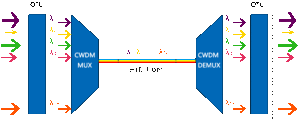What is Wavelength Division Multiplexing (WDM) Technology?
WDM combines a series of optical signals with different information but different wavelengths and transmits them along a single fiber. At the transmitting end, they are combined by a mux (also called a multiplexer) and coupled to the light. a technique for transmitting in the same fiber of a line; at the receiving end, a demux (also called a demultiplexer) separates optical signals of different wavelengths, and then is separated by an optical receiver. Further processing to restore the original signal. In the same fiber, two or more optical wavelength signals are simultaneously transmitted through different optical channels, which is called optical wavelength division multiplexing (WDM).

Features of WDM
(1) The bandwidth resources of the optical fiber can be fully utilized. So the transmission capacity of one optical fiber is several times, several tens of times, several hundred times larger than the single wavelength, and the optical fiber can be saved in a large amount. Thereby increasing the transmission capacity of the optical fiber and reducing the cost, and having great application value and economical price. WDM technology can make full use of the huge bandwidth of single-mode fiber, thus solving the transmission bandwidth problem to a large extent.
(2) It has good compatibility with different signals. With WDM technology, signals of different nature (audio, video, data, text, images, etc.) can be modulated at different wavelengths. Each wavelength is independent of each other and transparent to the data format and rate transmission, so it can be transmitted simultaneously.
(3) Transparent transmission. The wavelength division multiplexing channel is transparent to the data format, that is, independent of the signal rate and the electrical modulation mode. A WDM system can carry “business” signals in multiple formats.
(4) The network has good survivability. Using WDM technology routing to achieve network switching and recovery, it is possible to achieve transparent, highly survivable optical networks in the future.
(5) It can be flexibly networked. Using WDM’s routing technology, the network structure of the optical communication network can be adjusted without changing the cable network facilities, and flexibility and freedom in the design of the communication network can be facilitated to improve system functions and expand the application range.
WDM wavelength requirements
The wavelength of light in a WDM system must comply with ITU-T regulations for optical wavelengths in WDM systems.
Conclusion
WDM systems can be divided into two categories according to the wavelength band of the working wavelength: one is wavelength division multiplexing with large channel spacing throughout the long wavelength band, called coarse wavelength division multiplexing (CWDM); the other is at 1550 nm, called Dense Wavelength Division Multiplexing (DWDM). We will introduce these two technology at the next post.


